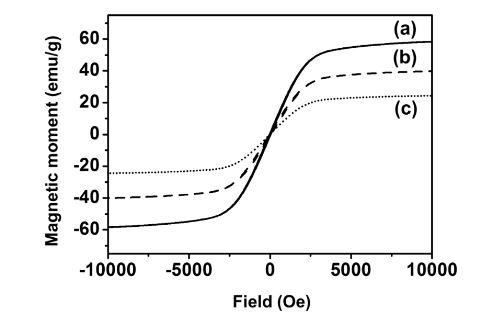ABSTRACT
This research describes the preparation and sensor applications of multifunctional mono disperse, Fe3O4 nano particles-embedded poly(styrene)/poly(thiophene) (Fe3O4-PSt/PTh), core/shell nano particles. Monodisperse Fe3O4-PSt/PTh nano particles were prepared by free-radical combination (mini-emulsion/emulsion) polymerization for Fe3O4-PSt core and oxidative seeded emulsion polymerization for PTh shell in the presence of FeCl3/H2O2 as a redox catalyst, respectively.
For applicability of Fe3O4-PSt/PTh as sensors, Fe3O4-PSt/PTh-immobilized poly(ethylene glycol) (PEG)-based hydrogels were fabricated by photolithography. The hydrogel patterns showed a good sensing performance under different H2O2 concentrations. They also showed a quenching sensitivity of 1 μg /mL for the Pd2+ metal ion within 1 min. The hydrogel micropatterns not only provide a fast water uptake property but also suggest the feasibility of both H2O2 and Pd2+ detection.
RESULTS AND DISCUSSION

Figure 1. A schematic illustration of the preparation of Fe3O4 nano particles-embedded
A schematic diagram of monodisperse Fe3O4-PSt/PTh core/shell nano particles is illustrated in Figure 1. Oleic acid-stabilized Fe3O4 nano particles were prepared by a co-precipitation method and dispersed into octane to form the ferrofluid. On the other hand, styrene droplets were prepared by membrane emulsification and the resulting droplets (~3 μm in diameter) are shown in the supporting information (Figure S1).

Figure 3. Magnetization hysteresis loops
As shown in Figure 3, the magnetic properties of Fe3O4, Fe3O4-PSt and Fe3O4-PSt/PTh core/shell nano particles were studied with SQUID magnetometry at room temperature as a function of external field (−1 to 1 Tesla). The zero coercivity and the reversible hysteresis behavior indicate the super paramagnetic nature of the nano particles.
EXPERIMENTAL SECTION
All reagents used in this work were analytic grade and available commercially. Ferric chloride (FeCl3∙6H2O), ferrous chloride (FeCl2∙4H2O), hexadecane (99%), styrene (St), thiophene (Th), Poly(ethylene glycol) diacrylate (PEGDA, M. W. = 575 g/mol), 2-hydroxy-2-methylpropiophenone (HOMPP, 97%) were purchased from Sigma-Aldrich (St. Louis, MA, USA).
CONCLUSIONS
We synthesized monodisperse Fe3O4-PSt/PTh core/shell nano particles successfully by combinational mini-emulsion/emulsion polymerization and oxidative polymerization. TEM and TGA results indicated that the high concentration (69 wt %) of Fe3O4 nano particles were embedded in the monodisperse PSt matrix even after PTh sheath formation during the oxidative polymerization.
The Fe3O4-PSt/PTh nanoparticles were then immobilized in crosslinked PEG hydrogel patterns for their applicability as sensors, and this was based on the quenching effect of H2O2 or Pd2+ ion. The variations in fluorescence intensity arising from H2O2 and the metal ion were evaluated with different concentrations and contact times. The results suggest that the Fe3O4-PSt/PTh nano particle could be a candidate for fluorescence quenching-based optical sensors providing a size and shape controllable multiplex detection system.
Source: Yonsei University
Authors: Yong Seok Kim | Hyun Jong Lee | Patakamuri Govindaiah | Woohyun Son | Won-Gun Koh | In Woo Cheong | Jung Hyun Kim